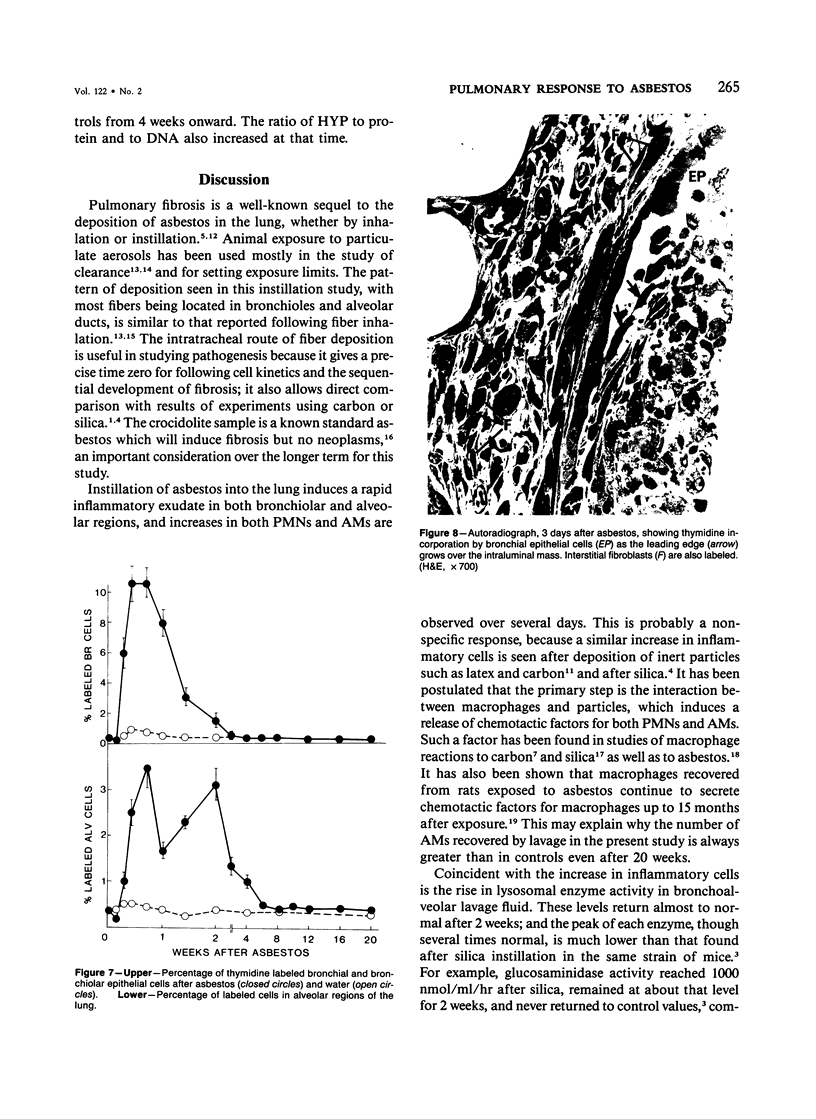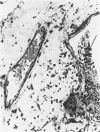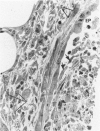Abstract
The responses of pulmonary alveolar and bronchial cells to asbestos exposure were studied by relating the cytokinetic changes of injury and repair to the inflammatory process and subsequent fibroblastic activity. The lesions were induced by intratracheal instillation of 1 mg crocidolite asbestos in mice, which were killed up to 20 weeks thereafter; 3H-thymidine was injected 1 hour before death. A rapid inflammatory response with elevated polymorphonuclear leukocytes and lysosomal enzyme release was largely over by 2 weeks, but the increase in alveolar macrophages was maintained. Focal necrosis of bronchial epithelial cells was repaired by cell regeneration, whereby new epithelial cells overgrew luminal exudates to incorporate long asbestos fibers into the peribronchial interstitium, where macrophagic granulomas formed. Increased collagen levels were largely due to stimulation of peribronchial fibroblasts. A lesser reaction of epithelial damage, Type 2 cell proliferation, and fibroblast stimulation also occurred in the alveolar walls. The results suggest that macrophage-fibroblast interactions associated with enhanced fibrosis occur readily in the peribronchial interstitium following injury and repair of epithelial cells by long asbestos fibers.
Full text
PDF






Images in this article
Selected References
These references are in PubMed. This may not be the complete list of references from this article.
- Aalto M., Heppleston A. G. Fibrogenesis by mineral fibres: an in-vitro study of the roles of the macrophage and fibre length. Br J Exp Pathol. 1984 Feb;65(1):91–99. [PMC free article] [PubMed] [Google Scholar]
- Adamson I. Y., Bowden D. H. Chemotactic and mitogenic components of the alveolar macrophage response to particles ad neutrophil chemoattractant. Am J Pathol. 1982 Oct;109(1):71–77. [PMC free article] [PubMed] [Google Scholar]
- Adamson I. Y., Bowden D. H. Dose response of the pulmonary macrophagic system to various particulates and its relationship to transepithelial passage of free particles. Exp Lung Res. 1981 Aug;2(3):165–175. doi: 10.3109/01902148109052312. [DOI] [PubMed] [Google Scholar]
- Adamson I. Y., Bowden D. H. Role of polymorphonuclear leukocytes in silica-induced pulmonary fibrosis. Am J Pathol. 1984 Oct;117(1):37–43. [PMC free article] [PubMed] [Google Scholar]
- Adamson I. Y., Bowden D. H. The type 2 cell as progenitor of alveolar epithelial regeneration. A cytodynamic study in mice after exposure to oxygen. Lab Invest. 1974 Jan;30(1):35–42. [PubMed] [Google Scholar]
- Bowden D. H., Adamson I. Y. The role of cell injury and the continuing inflammatory response in the generation of silicotic pulmonary fibrosis. J Pathol. 1984 Nov;144(3):149–161. doi: 10.1002/path.1711440302. [DOI] [PubMed] [Google Scholar]
- Brody A. R., Hill L. H., Adkins B., Jr, O'Connor R. W. Chrysotile asbestos inhalation in rats: deposition pattern and reaction of alveolar epithelium and pulmonary macrophages. Am Rev Respir Dis. 1981 Jun;123(6):670–679. doi: 10.1164/arrd.1981.123.6.670. [DOI] [PubMed] [Google Scholar]
- Brody A. R., Hill L. H. Interstitial accumulation of inhaled chrysotile asbestos fibers and consequent formation of microcalcifications. Am J Pathol. 1982 Oct;109(1):107–114. [PMC free article] [PubMed] [Google Scholar]
- Craighead J. E., Mossman B. T. The pathogenesis of asbestos-associated diseases. N Engl J Med. 1982 Jun 17;306(24):1446–1455. doi: 10.1056/NEJM198206173062403. [DOI] [PubMed] [Google Scholar]
- Davis J. M., Beckett S. T., Bolton R. E., Collings P., Middleton A. P. Mass and number of fibres in the pathogenesis of asbestos-related lung disease in rats. Br J Cancer. 1978 May;37(5):673–688. doi: 10.1038/bjc.1978.105. [DOI] [PMC free article] [PubMed] [Google Scholar]
- Davis J. M. The pathology of asbestos related disease. Thorax. 1984 Nov;39(11):801–808. doi: 10.1136/thx.39.11.801. [DOI] [PMC free article] [PubMed] [Google Scholar]
- Filipenko D., Wright J. L., Churg A. Pathologic changes in the small airways of the guinea pig after amosite asbestos exposure. Am J Pathol. 1985 May;119(2):273–278. [PMC free article] [PubMed] [Google Scholar]
- Harington J. S. Fibrogenesis. Environ Health Perspect. 1974 Dec;9:271–279. doi: 10.1289/ehp.749271. [DOI] [PMC free article] [PubMed] [Google Scholar]
- Heppleston A. G., Styles J. A. Activity of a macrophage factor in collagen formation by silica. Nature. 1967 Apr 29;214(5087):521–522. doi: 10.1038/214521a0. [DOI] [PubMed] [Google Scholar]
- Kagan E., Oghiso Y., Hartmann D. P. Enhanced release of a chemoattractant for alveolar macrophages after asbestos inhalation. Am Rev Respir Dis. 1983 Oct;128(4):680–687. doi: 10.1164/arrd.1983.128.4.680. [DOI] [PubMed] [Google Scholar]
- Lemaire I., Rola-Pleszczynski M., Bégin R. Asbestos exposure enhances the release of fibroblast growth factor by sheep alveolar macrophages. J Reticuloendothel Soc. 1983 Apr;33(4):275–285. [PubMed] [Google Scholar]
- Lugano E. M., Dauber J. H., Daniele R. P. Silica stimulation of chemotactic factor release by guinea pig alveolar macrophages. J Reticuloendothel Soc. 1981 Nov;30(5):381–390. [PubMed] [Google Scholar]
- Reiser K. M., Haschek W. M., Hesterberg T. W., Last J. A. Experimental silicosis. II. Long-term effects of intratracheally instilled quartz on collagen metabolism and morphologic characteristics of rat lungs. Am J Pathol. 1983 Jan;110(1):30–40. [PMC free article] [PubMed] [Google Scholar]
- Schoenberger C. I., Hunninghake G. W., Kawanami O., Ferrans V. J., Crystal R. G. Role of alveolar macrophages in asbestosis: modulation of neutrophil migration to the lung after acute asbestos exposure. Thorax. 1982 Nov;37(11):803–809. doi: 10.1136/thx.37.11.803. [DOI] [PMC free article] [PubMed] [Google Scholar]
- Warheit D. B., Chang L. Y., Hill L. H., Hook G. E., Crapo J. D., Brody A. R. Pulmonary macrophage accumulation and asbestos-induced lesions at sites of fiber deposition. Am Rev Respir Dis. 1984 Feb;129(2):301–310. [PubMed] [Google Scholar]
- Wright J. L., Churg A. Morphology of small-airway lesions in patients with asbestos exposure. Hum Pathol. 1984 Jan;15(1):68–74. doi: 10.1016/s0046-8177(84)80332-9. [DOI] [PubMed] [Google Scholar]







